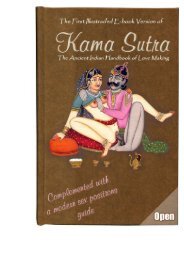body and health in yoga, Ayurveda, and Tantra
body and health in yoga, Ayurveda, and Tantra
body and health in yoga, Ayurveda, and Tantra
You also want an ePaper? Increase the reach of your titles
YUMPU automatically turns print PDFs into web optimized ePapers that Google loves.
ody <strong>and</strong> philosophies of heal<strong>in</strong>g 33<br />
dist<strong>in</strong>ct from Brahman, nor is prakÓrti unconscious (jaÓda) as it is for Yoga.<br />
As part of Brahman, prakÓrti is conscious, <strong>and</strong> by means of prakÓrti, Brahman<br />
manifests itself <strong>in</strong> the form of all the constituents of the manifest<br />
universe. 56 <strong>Tantra</strong>’s metaphysical presupposition that matter possesses<br />
consciousness is crucial: classical Yoga assumes that matter is unconscious,<br />
<strong>and</strong> aims for realization of Self as not-matter, but T¯antric <strong>yoga</strong><br />
utilizes the <strong>body</strong> as an <strong>in</strong>strument of liberation, <strong>and</strong> reveres its material<br />
nature as both conscious <strong>and</strong> sacred.<br />
While T¯antric metaphysics is non-dualistic (advait<strong>in</strong>), <strong>and</strong> regards<br />
Brahman, known as Param Íiva, as the one Reality, it allows for the apparent<br />
difference of the one Absolute <strong>and</strong> the multifarious manifest<br />
world. Íiva <strong>and</strong> Íakti are separable <strong>in</strong> empirical <strong>and</strong> cognitive analysis,<br />
but their identity is knowable through higher knowledge offered by T¯antric<br />
mysticism. 57 <strong>Tantra</strong> is non-dualistic like Ved¯anta, rather than dualistic<br />
like Yoga, but while Ved¯anta ultimately relegates the manifest world<br />
to the status of māyā or illusion, <strong>Tantra</strong> considers the manifest world as<br />
fully real. Ved¯anta regards māyā as “that power (Íakti) of Brahman by<br />
which the world of multiplicity comes <strong>in</strong>to existence.” 58 <strong>Tantra</strong> shares<br />
this <strong>in</strong>terpretation, but not Advaita Ved¯anta’s underst<strong>and</strong><strong>in</strong>g of māyā as<br />
the illusory ground <strong>and</strong> nature of subject-object dist<strong>in</strong>ctions.<br />
What is meant by call<strong>in</strong>g the world an illusion <strong>and</strong> at the same time ascrib<strong>in</strong>g<br />
existence to it? The answer is that for Advaita Ved¯anta the term<br />
“real” means that which is permanent, eternal, <strong>in</strong>f<strong>in</strong>ite, that which is<br />
trikālābādhyam, never subrated at any time by another experience—<strong>and</strong><br />
Brahman alone fits this mean<strong>in</strong>g. The world is not real, but it is not<br />
wholly unreal. 59<br />
For <strong>Tantra</strong> however, material nature (<strong>in</strong>clud<strong>in</strong>g the embodied human<br />
be<strong>in</strong>g) is a manifestation of Íiva-Íakti, has full reality, <strong>and</strong> is sacred <strong>in</strong> its<br />
orig<strong>in</strong> <strong>and</strong> fundamental nature. The human be<strong>in</strong>g as an aspect of creation<br />
is not-different from Param Íiva. This ontological position contributes to<br />
a more <strong>body</strong>-positive religious practice <strong>and</strong> soteriological goal than is<br />
found <strong>in</strong> orthodox H<strong>in</strong>duism.<br />
<strong>Tantra</strong>’s monistic view of the world <strong>and</strong> Brahman (as Íiva-Íakti) is<br />
free of the metaphysical problems confronted by the dualism of classical<br />
Yoga. Further, even though <strong>Tantra</strong> is monistic, it is able, unlike Advaita<br />
Ved¯anta, to preserve the particularity of entities. Rather than ascrib<strong>in</strong>g to<br />
particular entities a lower ontological status as mere appearances of<br />
Brahman (a consequence of Advaita Ved¯anta’s underst<strong>and</strong><strong>in</strong>g of māyā)<br />
T¯antric metaphysics does not consider particular entities <strong>in</strong> the manifest



